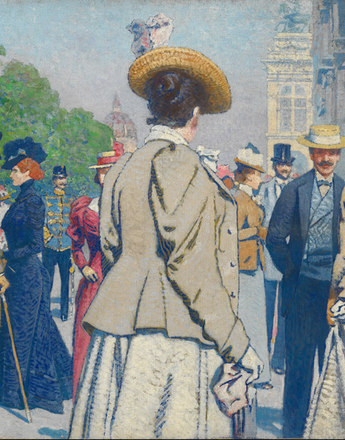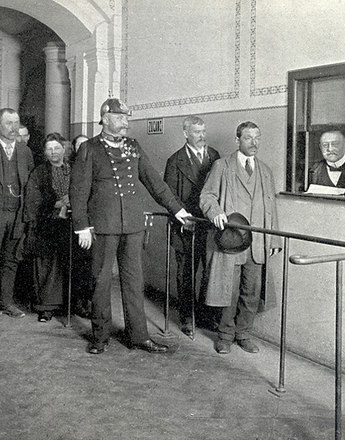The civil service was one of the most important linchpins of the Habsburg Monarchy and no less multifarious and complex than the state as a whole. It featured a strict hierarchy with a system of service ranks displaying intricate ramifications bordering on the incomprehensible. An addiction to titles was satisfied by a canon of forms of address that the present-day civil servant would regard as positively bizarre.
The administration of the vast and heterogeneous polity of Austria-Hungary was regulated by an intricate and precise allocation of responsibility and authority from the state ministries through the organs of provincial government down to the local authorities. Those serving in the highest reaches of the top bureaucracy formed a caste separated from all the others; the old aristocracy considered the civil service, like the army, a sphere of activity in keeping with their social standing. In addition there also existed a special civil service nobility made up of families who had worked in the administration for generations. The top positions in the central bureaucracy that had responsibility for both halves of the Monarchy were reserved for graduates carefully formed for service at the Theresianum.
But a middle- or even lower-ranking post was also considered desirable: in the authoritarian state of old Austria the civil servant commanded respect. An imperial and royal district commissioner, for example, saw himself as the worthy representative of the Emperor residing in far-off Vienna. And the knowledge that one was serving the power of the state endowed a certain ‘nobility’ even on a junior civil servant who was otherwise no more than a small cog in the machinery of administration.
A civil service post was considered a privilege – it meant a job for life, a fair chance of rising in the administration and in society, well-regulated working hours, a secure if modest income and, last but not least, a pension at the end of one’s working life.
The ethos of the civil service dated back to the enlightened absolutism of the late eighteenth century and the Josephinist ideal of the apolitical civil servant efficiently interpreting the law with impartial objectivity. While the imperial and royal administration indeed had its strengths (though some of these are still over-idealized today), it also had its darker sides, some of which died hard: imprisoned in formalities and hierarchies, the unquestioningly obedient civil servant was so accustomed to carrying out orders that he could all too easily become a cog in a machine being used to ride roughshod over human dignity and rights. The illusion of a civil service standing above party politics was destroyed by the omnipresence of nationalist and ideological groups. And on occasion even the most correct and incorruptible civil servant had to bow to pressure from ‘on high’.
One particular feature of the Habsburg Monarchy was that the civil service was all too often not controlled by the government but the government by the civil service. When Austrian parliamentarism was blocked by the conflicts between the nationalities, the Monarchy was governed by the state administration in a kind of ‘ministerial absolutism’. The frequently changing governments were generally strongly influenced by the top bureaucracy. Almost half of the ministers from 1867 onwards had had a career in the civil service and of 26 prime ministers 17 had been career civil servants.
This state patriarchalism was also reinforced by the absence of a strong civil society. The subjects of the Monarchy considered the state responsible for everything and expected it to have a solution to hand whenever a problem arose. The ever-increasing catalogue of tasks to be dealt with in a modern society thus led to a a corresponding constant increase in the Monarchy’s host of civil servants. In 1880 it had employed around 100,000 civil servants – by 1810 the number of posts had quadrupled to around 400,000.
That the servants of the state did not operate ‘in a vacuum’ is shown by the fact that the civil service was increasingly affected by the general tendency towards nationalism. Especially in the lower echelons, the factor of national background led to the bureaucracy becoming the scene of in-fighting over the distribution of jobs, with the Germans and Magyars being over-represented, the Czechs represented in approximate accordance with their actual proportion of the overall population, and all other nationalities grossly under-represented. In 1895, in order to maintain the plausibility of the claim to impartiality, a special decree was issued enjoining civil servants not to engage in any kind of agitation or express private opinions.
Translation: Peter John Nicholson
Hanisch, Ernst: Der lange Schatten des Staates. Österreichische Gesellschaftsgeschichte im 20. Jahrhundert [Österreichische Geschichte 1890–1990, hrsg. von Herwig Wolfram], Wien 2005
Křen, Jan: Dvě století střední Evropy [Zwei Jahrhunderte Mitteleuropas], Praha 2005
Rumpler, Helmut: Eine Chance für Mitteleuropa. Bürgerliche Emanzipation und Staatsverfall in der Habsburgermonarchie [Österreichische Geschichte 1804–1914, hrsg. von Herwig Wolfram], Wien 2005
Traum und Wirklichkeit. Wien 1870–1930. Katalog der 93. Sonderausstellung des Historischen Museums der Stadt Wien 1985, Wien 1985
Wandruszka, Adam (Hrsg.): Die Habsburgermonarchie 1848–1918, Band II: Verwaltung und Rechtswesen, Wien 1975
Das Zeitalter Kaiser Franz Josephs – 2. Teil: 1880–1916. Glanz und Elend. Katalog der Niederösterreichischen Landesausstellung auf Schloss Grafenegg 1987, Wien 1987
-
Chapters
- ‘God preserve Him, God protect Him’ – The Emperor
- The Army: Austria-Hungary in its entirety
- The bureaucracy as the long arm of the state
- The Dual Monarchy: two states in a single empire
- ‘Indivisible and inseparable’ – the supranational state
- The Habsburg Monarchy in the process of democratization
- The absence of political culture
- A strong monarch and autocratic tendencies



